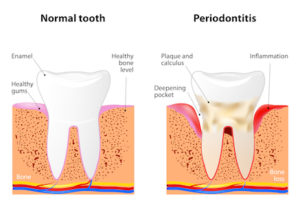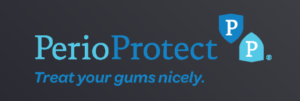Gum disease is an inflammation of the gum line. If it is left untreated, it can damage the bones that support your teeth. Symptoms of gum disease can include swollen, tender, or bleeding gums. You could also suffer from receding gums or persistent bad breath. Screening and treatment are available at our Surrey, BC dentist office.
More About Gum Disease Treatment Surrey, BC
 When your body senses threats like infections, lacerations, or foreign bacteria, it rushes to try to heal and protect the area being threatened. This inflammatory response in healthy individuals kills off bacteria and helps to speed healing.
When your body senses threats like infections, lacerations, or foreign bacteria, it rushes to try to heal and protect the area being threatened. This inflammatory response in healthy individuals kills off bacteria and helps to speed healing.
Unfortunately, when your body detects plaque, tartar and bacteria in your mouth, instead of actively attacking the bacteria, your gum tissue tries to protect itself by backing away.
If the early stages of gum disease are left untreated, gums will recede away from the teeth, which can trigger other dental and systemic health problems.
Signs Of Gum Disease
Gum disease hurts millions of people each year and many don't even know they don't have this serious condition until it has advanced to a point that requires treatment by a dentist.
However, you can be aware of these common symptoms of gum disease:
- Loose teeth or teeth separating from each other
- Mouth pain - including swollen and red gums
- Receding gums
- Excessive bleeding after brushing and flossing your teeth
- Mouth sores
- Consistent bad breath that doesn't respond to traditional treatment, like mouthwash
- Noticeable pus between your teeth and gums
- Your partial dentures aren't fitting securely anymore
- A change in the way you bite or the way your teeth fit together
If you're concerned you might be seeing the signs of gum disease, schedule an appointment with Southridge Dental today. We can assess your symptoms and create a treatment plan specialized to your dental needs.
Gingivitis Treatment
Gingivitis is often painless at first, making it difficult to diagnose without regular dental checkups. Inflammation of the gums can be a potentially serious condition, which is why it’s vital to get regular dental exams from Southridge Dental.
If you have been diagnosed with or are concerned you might have gingivitis, our team provides a range of treatments to reverse or stop gum disease’s progression. If you are in the early stages of gingivitis, most treatment options don't require surgery.
Perio Protect
 Southridge Dental provides gentle gum disease treatment in Surrey with Perio Protect®. In addition to your regular preventive teeth cleaning appointments, you will wear the Perio Tray® at home to deliver medication between dental visits.
Southridge Dental provides gentle gum disease treatment in Surrey with Perio Protect®. In addition to your regular preventive teeth cleaning appointments, you will wear the Perio Tray® at home to deliver medication between dental visits.
Many patients suffering from periodontal disease only need to wear the tray for a few minutes a day to effectively treat their gum disease symptoms.
Have Questions About Your Gum Disease Treatment Surrey Options?
Are you experiencing the signs of gum disease? Don't put off your treatment any longer! Call Southridge Dental today so we can answer any questions you have and schedule your dentist appointment as soon as possible.
Do you snore or suffer from sleep apnea? At Southridge Dental, our goal is to help you get the quiet, restful sleep you deserve!
Soft Tissue Grafting Procedures for Gum Recession
Soft tissue grafting can be used to reduce and reverse the negative effects of gum recession. This type of procedure involves relocating healthy soft tissue into the area where the gums have receded. As a result, the area where recession has occurred is provided with new, healthy gum tissue that connects to the existing tissue, resulting in greater coverage.
How Gum Grafting Works
For a gum grafting procedure, incisions are typically made around the area where the graft is required. New tissue is then inserted under the existing tissue and sutured in place, where it will heal into place and begin to regenerate.
There are three grafting techniques that can be used to restore the gums:
- Connective tissue grafting
- Allograft tissue grafting
- Free gingival grafting
The type of grafting procedure recommended for an individual will depend on several factors, including:
- The extent of gum recession
- The amount of remaining healthy tissue
- The number of areas where grafting is required
- The availability of healthy tissue in other areas of the mouth
- The decision to use tissue from the patient’s mouth or to use sterilized donor tissue (alloderm)
- The overall oral health of the patient
Regardless of the type of grafting technique used, it’s very important that aftercare procedures are followed carefully, and oral hygiene routines are maintained. This will prevent further recession of the gums after the tissue has been restored and lead to better coverage and tooth root support.
Connective Tissue Grafting
Connective tissue grafting is the most common type of grafting procedure performed. It provides a more robust coverage for large areas of exposure. It works well when the gums have receded significantly and there is very little tissue left. In addition to adding coverage to the gums, connective tissue grafts can restore tooth root support over time.
In this type of graft, a small section of connective tissue is removed from under a flap in the roof of the mouth and sutured to the areas which require grafting. The flap is then sewn closed, and the tissue begins healing quickly.
Connective tissue grafting is also well-suited when cosmetic concerns are a strong consideration. This type of grafting provides better colour-matching and can look more natural when complete.
Connective tissue grafting is also known as subepithelial connective tissue grafting.
Allograft Tissue Grafting
Allograft tissue grafting corrects gum recession by using sterilized donor tissue (alloderm) rather than tissue taken from the roof of the patient’s mouth. The alloderm material is taken from donor tissue and then processed to remove the epidermis and create a regenerative tissue that can be used in grafting.
Alloderm is most often used when there are many areas of the mouth that require soft tissue grafting. This option is beneficial for those who do not have enough healthy donor tissue to supply from another area of the mouth.
In some cases, patients will choose allograft tissue grafting if they do not want their own tissue used in the graft, either because they are nervous about the procedure or because they want to reduce the pain and recovery at the site of removal.
Free Gingival Grafting
Free gingival grafting offers a more precise form of grafting. It can be helpful in treating smaller or less advanced areas of recession, as it adds thickness to the gums in areas where some gum tissue remains.
In free gingival grafting, a portion of epithelial (surface) tissue is taken from the upper roof of the mouth and moved to the grafting site, where it is sutured in place over the existing gums. Unlike in connective tissue grafting, an outer surface layer of tissue can be used for the graft, rather than the deeper connective tissue.
By adding thickness to the gums, gingival grafting prevents further recession. It also ensures the gums can withstand chewing and eating movements. However, because these types of grafts add more bulk to the gum line, they may be less aesthetically pleasing.
Free gingival grafting is sometimes also known as free epithelial soft tissue grafting.
Other Considerations for Gum Grafting
In most cases, gum grafting is a quick procedure that can be performed with a local anesthetic in under one hour. The full healing process takes about three months, with most of the healing happening in the first three weeks.
Your dental team at Southridge Dental will make sure you have everything you need for a successful and comfortable healing period. You’ll be given a list of aftercare instructions and foods to avoid. After that, you’ll need to visit us again for a check-in to ensure your healing is progressing as expected.
